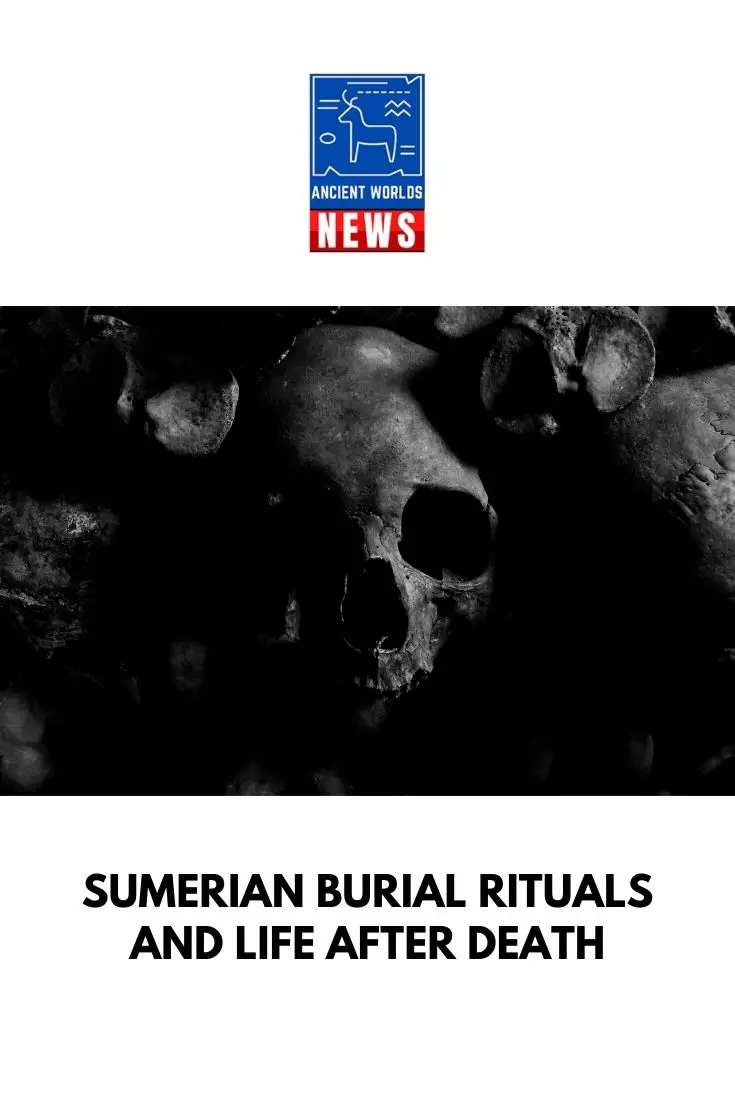According to Sumerian myth, humans were created by the gods out of clay. Additionally, one of the gods themselves was sacrificed and his blood mixed with the clay that formed the first human beings. In this way, God’s very presence is in all human beings. The main reason why the gods created human beings was so people could serve them. Initially, they were immortal, but with time, they became rebellious. This angered the gods, and they decided to destroy human beings. This is how death came about.
The Sumerians believed in life after death, and they pictured the afterlife as a dark place full of the miserable shadows of dead people. Since death was nothing to look forward, long life was treasured and considered a blessing. The place where dead people resided was called Kur. The goddess Ereshkigal was believed to be the ruler of Kur.

The entrance to Kur was supposedly located far east in the Zagros Mountains. There were seven gates for souls to enter through. The god Neti was the gatekeeper, and the god Namtar was Ereshkigal’s messenger. In the underworld, a class of demons known as Gallas would drag the weak and unlucky down into Kur. According to some texts, they were seven in number.
Life after Death
The Sumerians believed that death did not discriminate, and all people went to Kur after they died. This meant that people were not given special treatment based on their behavior. Even though there are Sumerian myths about fierce judges, such as Anunnaki, who lived in the palace of justice, there is no evidence that the righteous experienced a better afterlife than the non-righteous.
According to the Sumerians, the dead lived in a land beneath the earth, so they dug graves in the ground to enable the deceased to more easily get to the underworld. People who were not from royal families were buried under the family home or adjacent to it so that family members would occasionally tend their graves. The dead were feared; if a person was not buried properly, the living worried that the dead would come back as ghosts and haunt them.
Similar to other ghost stories, the spirits would have no bodies, and they would cause havoc or even enter someone else’s body and destroy their health. How people buried their dead also made a difference; those given a luxurious sendoff were treated better in Kur than those given poor burials. The treasures that wealthy people were buried with were meant to bribe the gods Anunnaki and Utu in exchange for special treatment in the afterlife.
The Sumerians also believed that the souls could only eat dry dust. Some sources, however, indicate that it was mandatory to bury the dead with food because an undernourished corpse would return and haunt the living. Relatives would occasionally encourage their dead to “drink” through a clay pipe staked in their grave.
Funeral Services
Not everyone was allowed a funeral service in Sumer. Criminals, women who died during childbirth, and those who had aborted were denied funerals. The Sumerians were very keen on establishing a person’s moral uprightness before granting funeral services. The extremely poor were also not given a sendoff.
The Sumerians started burying their dead around 5000 BCE. When a person died, they would bury them in baskets woven with twigs and put them in brick coffins. The graves were arranged regularly depending on the year of death.
Cremation was not very common in the Sumerian religion. One of the reasons for this was that wood was scarce. The second and main reason was the belief that the souls of the departed belonged beneath the earth and not in the domain of the gods. During cremation, souls are released up towards where the gods dwell. Human beings were not allowed to live there, so it was best that a soul went to the Ereshkigal’s kingdom because there it would co-exist with other human souls.
The deceased were buried with tools, food, and other valuable possessions. The tools were mainly determined by what a person’s relatives thought they would need in the underground. Everyone was buried with these items, no matter their social status. Many of these tools have since been excavated; the ones from royal graves consist of precious stones and gold, while the grave of a commoner would contain stone figurines.
Conclusion
In the beginning, human beings were not meant to die, but after they rebelled against the gods, they were punished with death. While common people were buried in graves next to the homes of their descendants, royal people were buried in special graves. They were also buried with more extravagant tools than those possessed by common people, even though the Sumerians believed that all people were treated equally in the afterlife, regardless of their social status or whether or not they lived righteously.
In Sumer, the dead were powerful, and they would bring blessings or curses upon their descendants and give or deny them children. Therefore, relatives would do everything possible to appease the departed souls by burying them correctly – with the right tools and food, not speaking ill of them, and tending to their graves regularly. At least once a month, offerings that included butter, beer, milk, or grain were brought.

